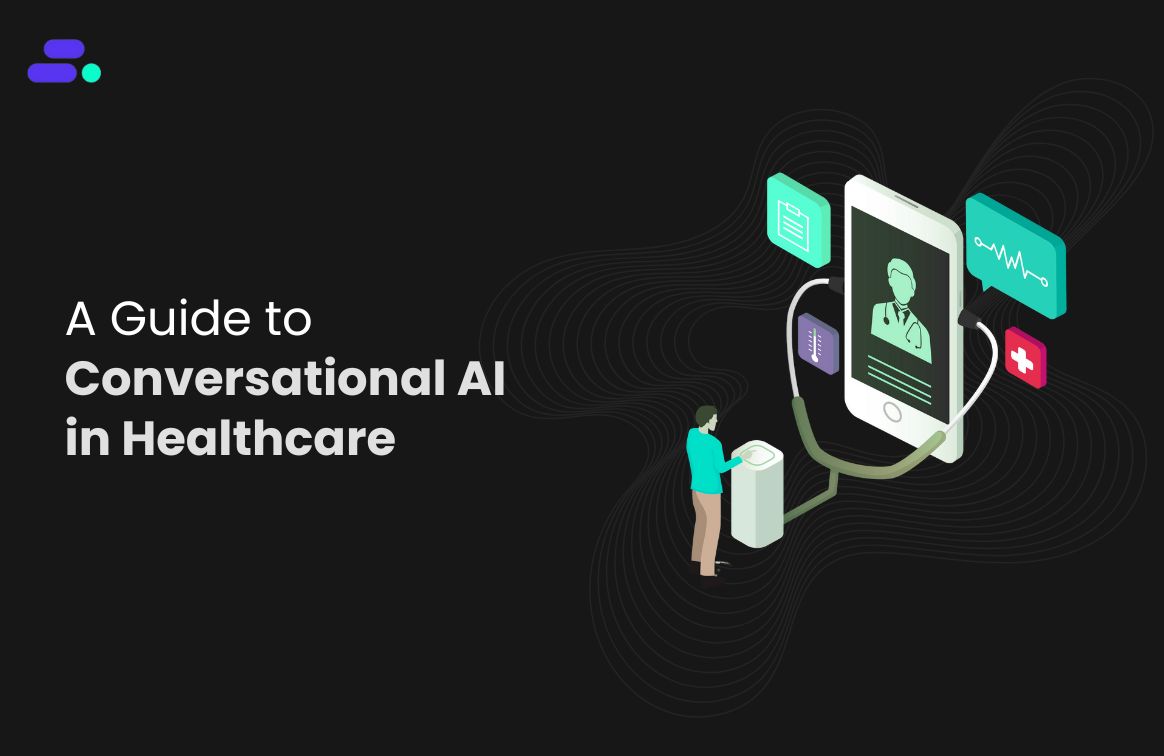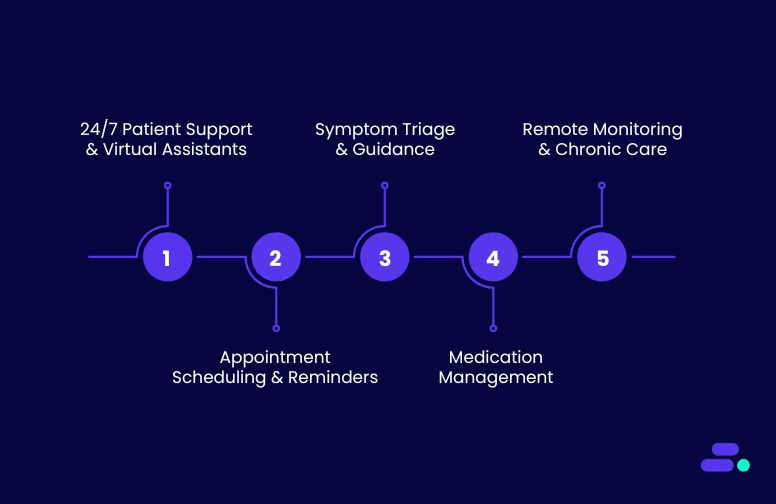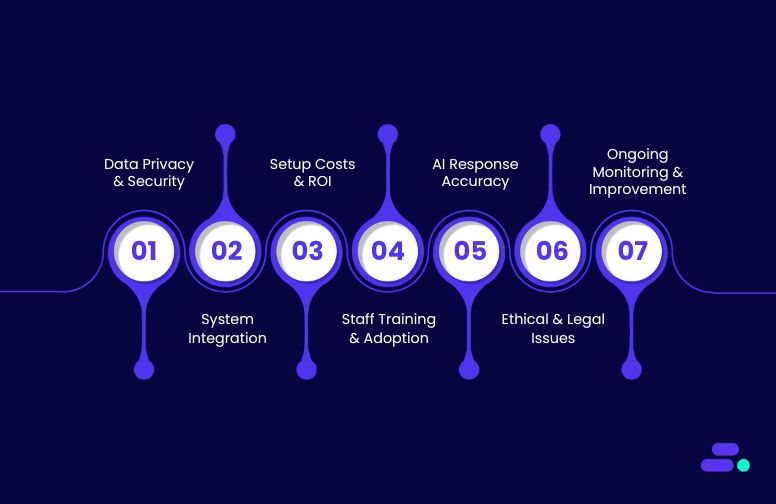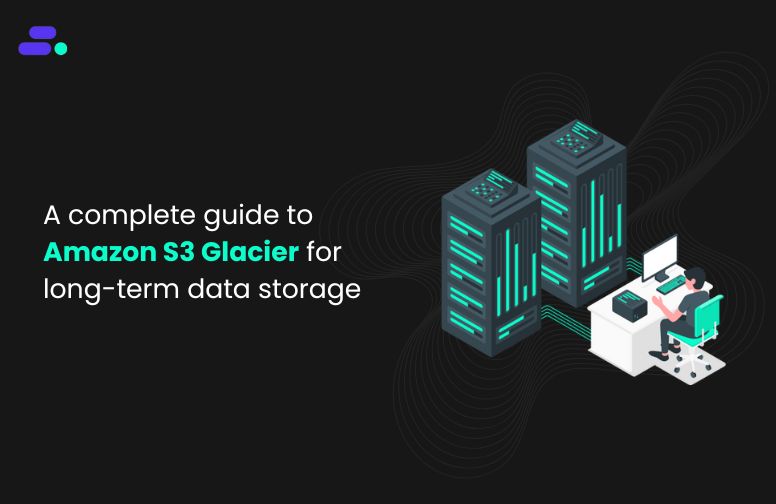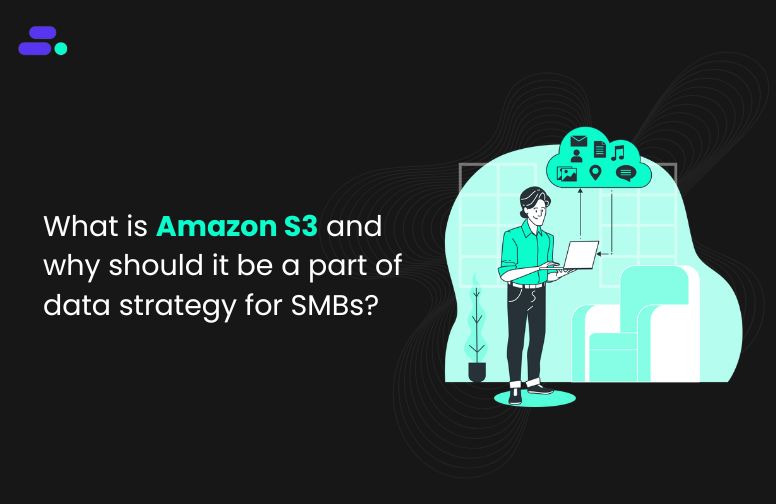This is a div block with a Webflow interaction that will be triggered when the heading is in the view.
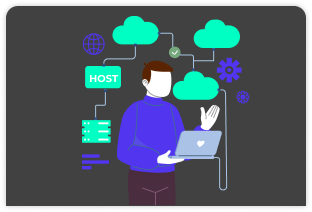
Modernize your cloud. Maximize business impact.
For decades, business intelligence (BI) meant heavy servers, long data refresh cycles, and reports that were outdated by the time they reached decision-makers. But today, cloud analytics is changing the game.
Unlike legacy BI locked to hardware limits and delayed refreshes, cloud analytics delivers real-time insights with elastic computing power. It integrates data from CRMs, ERPs, and even IoT devices into one view without costly servers or complex maintenance. SMBs pay only for what they use while gaining faster decisions, smarter forecasting, and enterprise-grade security.
Simply put, cloud analytics replaces static reports with live intelligence that drives agility and growth. This blog explores how it differs from legacy BI, the key benefits it brings to SMBs, and why it’s emerging as the smarter investment for long-term ROI.
Key takeaways:
- Faster insights: Cloud analytics delivers real-time dashboards and automated pipelines, enabling SMBs to act on data instantly.
- Lower total cost of ownership: Pay-as-you-go pricing reduces capital expenses and IT overhead compared to legacy BI.
- Elastic scalability: Cloud analytics adapts seamlessly to growing datasets, users, and workloads without costly infrastructure upgrades.
- AI-driven intelligence: Integrated machine learning and predictive analytics help SMBs anticipate trends, detect anomalies, and optimize decisions.
- Enhanced collaboration: Centralized, secure dashboards allow distributed teams to access the same live data, ensuring consistent, data-driven decision-making.
How is cloud analytics different from legacy BI?
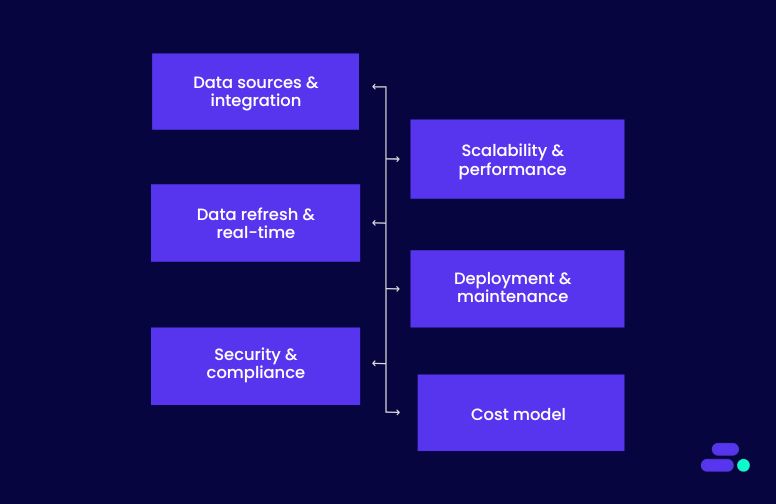
Traditional business intelligence (BI) was designed for a world where data lived primarily on-premises. Reports were generated through batch processes, relying on structured data pulled from relational databases.
While this approach worked in the past, it now struggles under the weight of modern requirements, including massive data volumes, real-time decision-making, and seamless integration with diverse data sources. Cloud analytics reshapes this landscape by re-architecting how data is collected, stored, processed, and visualized.
When comparing legacy BI with cloud analytics, the differences become clear across integration, scalability, performance, and cost:
Cloud analytics fundamentally redefines BI by making it scalable, real-time, and cost-efficient, while legacy BI remains rigid, hardware-bound, and slow to adapt.

In what ways does cloud analytics outperform traditional BI?
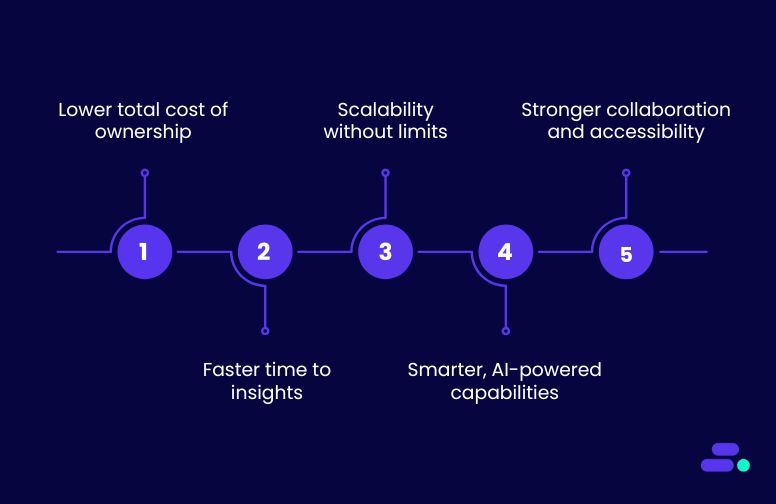
Cloud analytics empowers SMBs to compete at enterprise scale by combining real-time data pipelines, serverless processing, and elastic infrastructure. Instead of waiting on static reports, decision-makers can query live data, run advanced analytics, and visualize results instantly.
On AWS, services like Amazon Redshift, Athena, Glue, and QuickSight work together to streamline ingestion, transformation, and reporting, removing the bottlenecks that once limited smaller organizations. The result is faster insights, lower costs, and the ability to pivot strategies based on what the data says in the moment.
There are multiple ways in which cloud analytics creates measurable advantages over traditional BI for SMBs:
1. Lower total cost of ownership
Every dollar spent on technology needs to justify itself in business outcomes. Traditional BI tools come with a hidden cost burden, including expensive servers, perpetual licenses, and high IT overhead. Cloud analytics shifts this model to a lean, predictable framework, making advanced insights accessible without draining budgets.
How cloud analytics reduces TCO compared to legacy BI:
- No upfront CapEx: Legacy BI often requires six-figure investments in physical servers, data storage systems, and proprietary software. Cloud analytics removes this capital expense entirely, replacing it with subscription or usage-based pricing.
- Reduced IT labor costs: On-prem BI environments require teams for system monitoring, upgrades, and troubleshooting. With cloud analytics, infrastructure maintenance is handled by providers like AWS, allowing SMB IT teams to focus on strategy, not upkeep.
- Pay for what is used: Traditional BI locks organizations into fixed hardware and licensing costs, regardless of usage. Cloud analytics services charge based on actual consumption, ensuring costs scale proportionally with business activity.
Transitioning from traditional BI to lower-TCO cloud analytics on AWS:
- Replace hardware with cloud warehousing: Move from costly, license-heavy databases to Amazon Redshift, which delivers fast analytics with no physical infrastructure.
- Cut ETL tooling costs: Retire expensive, on-prem data prep tools by adopting AWS Glue, which runs ETL jobs serverlessly and only incurs cost while jobs are running.
- Avoid dashboard licensing fees: Replace per-user BI tools with Amazon QuickSight, which charges per session, not per seat, reducing costs for teams with variable usage.
Modernizing BI on AWS gives access to enterprise-grade analytics without the financial baggage of legacy infrastructure, providing true cost efficiency that legacy BI simply cannot match.
2. Faster time to insights
In fast-moving markets, decisions delayed are opportunities lost. Legacy BI systems require months of setup, manual data integration, and batch-based reporting that leaves leaders working with stale insights.
Cloud analytics flips this model by enabling rapid deployment, real-time dashboards, and automated pipelines, giving SMBs intelligence at the speed of business.
How cloud analytics accelerates time to insights compared to legacy BI:
- Rapid deployment: Traditional BI requires lengthy hardware provisioning and software configuration. Cloud analytics launches in days or weeks, with services ready to scale instantly.
- Real-time processing: Legacy BI refreshes data in overnight or weekly cycles. Cloud analytics ingests and analyzes streaming data continuously, powering live dashboards.
- Automated workflows: Manual ETL processes in legacy BI slow reporting cycles. With cloud analytics, automation replaces human intervention, reducing delays and errors.
Transitioning from traditional BI to faster insights on AWS:
- Enable real-time ingestion: Replace batch data transfers with Amazon Kinesis for streaming data pipelines that process events as they happen.
- Automate data prep: Use AWS Glue to schedule or trigger ETL jobs that run serverlessly, eliminating bottlenecks from manual processing.
- Deliver instant dashboards: Deploy Amazon QuickSight for interactive dashboards that auto-refresh with live data sources, ensuring decision-makers always see the latest view.
Cloud analytics allows SMBs to shorten the gap between data collection and decision-making, moving from hindsight to real-time foresight that legacy BI simply cannot deliver.

3. Scalability without limits
As SMBs grow, their data and user demands can surge unpredictably. Traditional BI platforms struggle under these spikes, requiring costly hardware upgrades or capacity planning that often leads to wasted resources.
Cloud analytics eliminates these constraints by offering elastic scaling, allowing organizations to handle increasing data volumes, users, and workloads seamlessly.
How cloud analytics delivers scalable performance compared to legacy BI:
- Elastic compute and storage: Legacy BI needs new servers or storage to scale. Cloud analytics automatically expands capacity to meet demand without manual intervention.
- Support for more users and workloads: Adding new teams or applications to legacy BI often slows the system. Cloud analytics accommodates additional users and concurrent queries with no performance drop.
- Instant onboarding of data sources: Legacy BI integrations are slow and resource-intensive. Cloud analytics can quickly ingest and process new structured or unstructured data from multiple sources.
Transitioning from traditional BI to scalable cloud analytics on AWS:
- Adopt Amazon Redshift: Use a fully managed data warehouse that automatically scales compute and storage based on query volume and dataset size.
- Utilize Amazon Athena: Query large datasets in Amazon S3 without provisioning infrastructure, paying only for what businesses use.
- Integrate with AWS Glue: Seamlessly prepare and catalog new data sources, allowing pipelines to scale without downtime or complex reconfiguration.
AWS cloud analytics gives the flexibility to grow without worrying about infrastructure limits, ensuring insights remain fast and reliable regardless of business scale.
4. Smarter, AI-powered capabilities
Traditional BI focuses on descriptive reporting, such as what happened in the past. Cloud analytics, however, integrates AI and machine learning to deliver predictive insights, detect anomalies, and surface trends automatically. This enables SMBs to move from reactive decision-making to proactive strategy, uncovering opportunities and risks before they escalate.
How cloud analytics leverages AI better than legacy BI:
- Predictive insights: Legacy BI relies on historical reports; cloud analytics uses services like Amazon SageMaker to forecast sales, demand, or operational trends.
- Anomaly detection: Cloud platforms automatically flag outliers or unusual patterns in real time, reducing the risk of overlooked issues.
- Automated recommendations: AI models embedded in analytics pipelines can suggest actions, such as optimizing inventory or marketing campaigns, without manual analysis.
Transitioning from traditional BI to AI-powered cloud analytics on AWS:
- Train and deploy models with Amazon SageMaker: Use historical and live data to build machine learning models that enhance reporting with predictions.
- Integrate AI into dashboards: Connect Amazon SageMaker insights to Amazon QuickSight dashboards, providing visualized, actionable intelligence.
- Automate alerts and workflows: Combine predictions with AWS Lambda and AWS Step Functions to trigger automated responses or notifications for anomalies.
Adopting AI-enhanced cloud analytics allows SMBs to anticipate trends, act on insights faster, and gain a competitive edge that legacy BI systems cannot deliver.

5. Stronger collaboration and accessibility
In today’s distributed work environment, decision-making requires real-time access to the same data across teams and locations. Traditional BI often delivers static reports that are shared manually, creating delays and inconsistencies. Cloud analytics ensures that all stakeholders from finance to operations work from a single source of truth, improving transparency and enabling coordinated, data-driven decisions.
How cloud analytics enhances collaboration compared to legacy BI:
- Shared, live dashboards: Legacy BI reports are static and emailed, causing version control issues. Cloud analytics platforms like Amazon QuickSight provide live, interactive dashboards accessible to all authorized users.
- Role-based access: Teams can see relevant data without compromising security. AWS tools such as IAM and Lake Formation ensure proper permissions while maintaining centralized governance.
- Seamless cross-department access: Cloud analytics allows multiple teams to query, visualize, and act on the same datasets simultaneously, eliminating silos and improving consistency.
Transitioning from traditional BI to collaborative cloud analytics on AWS:
- Centralize datasets in Amazon S3 and Amazon Redshift: Create a single source of truth that multiple teams can access in real time.
- Use Amazon QuickSight for interactive dashboards: Deploy dashboards that update automatically and support multi-user collaboration across locations.
- Enforce governance and security: Apply IAM policies and AWS Lake Formation rules to control access, ensuring compliance while enabling collaboration.
Moving to cloud analytics empowers distributed teams to make consistent, transparent, and faster data-driven decisions, something legacy BI struggles to achieve.

Cloud infrastructure offers SMBs the scalability, resilience, and agility on-premises can’t, but success requires strategy. Cloudtech, an AWS Advanced Tier Partner, pairs certified expertise with SMB-focused solutions to deliver secure, cost-efficient, and high-performing cloud analytics.
How does Cloudtech help SMBs realize the benefits of cloud analytics?
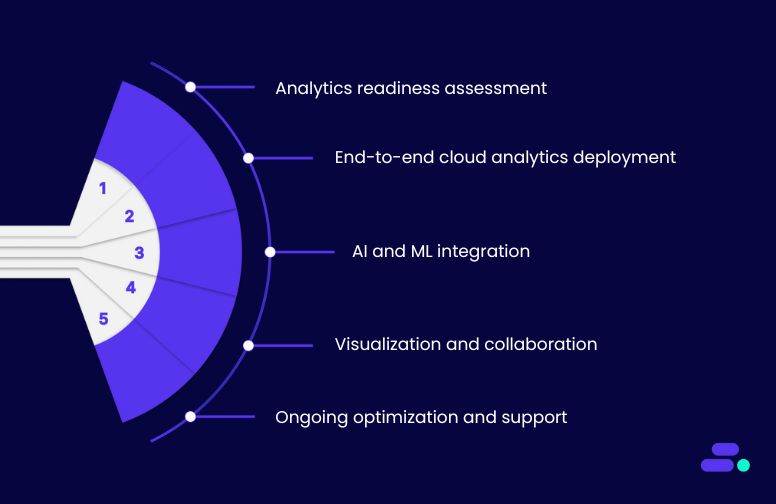
Adopting cloud analytics isn’t just about moving dashboards online. It’s about transforming how SMBs collect, process, and act on data. Partnering with an AWS expert like Cloudtech provides certified guidance, proven frameworks, and cost-optimized strategies that align analytics infrastructure with business goals, ensuring faster insights, lower TCO, and scalable performance.
Cloudtech’s SMB-first approach focuses on solutions that fit lean budgets while enabling growth. It automates pipelines, integrates AI-powered analytics, and embeds security and compliance from the start, enabling businesses to turn data into actionable intelligence efficiently.
Key Cloudtech services for cloud analytics:
- Analytics readiness assessment: Cloudtech evaluates current BI systems, identifies bottlenecks, outdated workflows, and data silos, and recommends optimized cloud-based architectures.
- End-to-end cloud analytics deployment: Using AWS tools such as Amazon Redshift, Amazon Athena, and AWS Glue, Cloudtech sets up scalable, high-performance data pipelines and storage.
- AI and ML integration: SMBs can utilize Amazon SageMaker for predictive analytics, anomaly detection, and trend forecasting, delivering insights beyond traditional reporting.
- Visualization and collaboration: Interactive dashboards built on Amazon QuickSight provide real-time insights accessible to multiple teams, enabling data-driven decision-making across the organization.
- Ongoing optimization and support: Cloudtech continuously monitors pipelines, refines AI models, and ensures costs and performance remain optimized, allowing SMBs to focus on growth rather than infrastructure.
With these services, SMBs gain a cloud analytics environment that is scalable, intelligent, and cost-efficient.
See how other SMBs have modernized, scaled, and thrived with Cloudtech’s support →

Wrapping up
Modern SMBs need insights that are fast, accurate, and accessible across teams, which are capabilities legacy BI struggles to provide. In contrast, cloud analytics delivers real-time intelligence, scalable infrastructure, and AI-powered tools that drive smarter decision-making and lower total cost of ownership.
Partnering with an AWS expert like Cloudtech ensures analytics adoption is strategic, not just a migration. Cloudtech helps SMBs implement cloud-native data pipelines, predictive models, and interactive dashboards that are secure, compliant, and tailored to business goals. They gain a cloud analytics environment that turns data into actionable insights, accelerates decisions, and provides a competitive edge.
Connect with Cloudtech today and achieve smarter, faster, and more cost-efficient analytics!
FAQs
1. What types of SMB data can be analyzed with cloud analytics?
Cloud analytics can process structured data from ERP and CRM systems, semi-structured data from CSV or JSON files, and unstructured data like emails, social media feeds, and IoT device streams. This versatility allows SMBs to generate comprehensive insights from all relevant sources.
2. How does cloud analytics support real-time decision-making?
Unlike traditional BI, cloud analytics can ingest streaming data from multiple sources and update dashboards continuously. SMBs can monitor sales, inventory, or operational metrics in near real time, enabling faster, data-driven responses.
3. Can SMBs start small with cloud analytics and scale later?
Yes. Cloud analytics platforms on AWS allow SMBs to pay only for the storage and compute they use. Teams can start with core datasets and dashboards, then scale to more users, workloads, or AI-driven analytics as business needs grow.
4. How secure is cloud analytics for sensitive SMB data?
Cloud analytics leverages encryption at rest and in transit, identity-based access controls (IAM), and audit logging. With AWS services like Lake Formation and CloudTrail, SMBs can maintain compliance with industry regulations while keeping data secure.
5. How does AI enhance cloud analytics compared to legacy BI?
AI and machine learning enable predictive modeling, anomaly detection, and automated recommendations. SMBs can anticipate trends, identify risks, and uncover growth opportunities without relying solely on historical reporting.

Get started on your cloud modernization journey today!
Let Cloudtech build a modern AWS infrastructure that’s right for your business.
